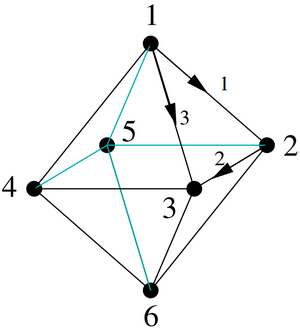Science:Math Exam Resources/Courses/MATH307/April 2012/Question 04 (a)
{{#incat:MER QGQ flag|{{#incat:MER QGH flag|{{#incat:MER QGS flag|}}}}}}
• Q1 (a) • Q1 (b) • Q1 (c) • Q1 (d) • Q2 (a) • Q2 (b) • Q2 (c) • Q3 • Q4 (a) • Q4 (b) • Q4 (c) • Q4 (d) • Q4 (e) • Q5 (a) • Q5 (b) • Q5 (c) • Q6 (a) • Q6 (b) • Q6 (c) • Q6 (d) • Q7 (a) • Q7 (b) • Q7 (c) • Q8 (a) • Q8 (b) • Q8 (c) •
Question 04 (a) |
|---|
|
Consider a network arranged in the shape of an octahedron as in this diagram: The nodes have been labeled with the large numbers and 3 of the edges (resistors) have been given orientations and labeled with small numbers. Assume all resistances are equal to 1. Let D be the incidence matrix (for some choice of labeling and arrows for the remaining edges) and let L be the Laplacian. (a) Write down a non-zero vector in N(D). |
|
Make sure you understand the problem fully: What is the question asking you to do? Are there specific conditions or constraints that you should take note of? How will you know if your answer is correct from your work only? Can you rephrase the question in your own words in a way that makes sense to you? |
|
If you are stuck, check the hint below. Consider it for a while. Does it give you a new idea on how to approach the problem? If so, try it! |
Hint |
|---|
|
Science:Math Exam Resources/Courses/MATH307/April 2012/Question 04 (a)/Hint 1 |
|
Checking a solution serves two purposes: helping you if, after having used the hint, you still are stuck on the problem; or if you have solved the problem and would like to check your work.
|
Solution |
|---|
|
Looking at the resistor network, we can make the incidence matrix where the columns are the nodes and the rows are the edges.
The first column represents node 1, the second column represents node 2, and the third column represents node 3. An entry of -1 represents an edge leaving the corresponding node column, and an entry of 1 represents an edge entering the corresponding node column. To find the nullspace of D, we have to find all vectors that are solutions to . For matrix D, it is pretty easy to see that or any multiple of this as only solution to . Therefore:
Proof:
Check: . FINAL ANSWER
|
{{#incat:MER CT flag||
}}









